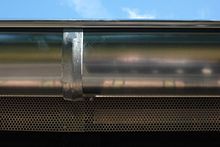Underlay
A sarking membrane (USB) is a flat component that is placed below the water-draining roof covering on pitched roofs . It is used to divert downward snow or rain that is blown by the wind under the roofing. It is stretched freely between the rafters and must be rear-ventilated on both sides (primary ventilation level).
In contrast to this, roofing felt , formwork sheets and vapor diffusion- open roofing sheets lie on one formwork level (mostly in the form of a continuous board layer). Façade membranes are used on vertical surfaces.
Water vapor diffusion
Openness to diffusion does not initially play a role in roofing membranes. A typical Sd value of underlays that are not optimized for vapor permeability is 3 m.
Insulation between the rafters must, however, keep a distance of at least 2 cm from the sarking membrane if this is not permeable to diffusion in order to ensure that the air humidity moving from the inside to the outside is transported away. The water vapor is transported from the eaves to the ridge by a stream of air beneath the runway through thermal lift . In this case one speaks of a cold roof .
In order to enable this air flow, it is important to ensure that the inflow openings on the eaves are not closed, that the sheets end shortly before the ridge (to allow the moist air to escape from under the ridge tiles that are installed at a certain distance) and that below and above from roof installations such as roof windows, dormers and chimneys the air can enter and exit through ventilation tiles.
However, if an insulation layer is installed right up to the membrane (e.g. cellulose insulation that is subsequently blown in ), it is called a warm roof . In this case, the membrane must be a vapor- permeable underlay membrane. A typical Sd value is 0.02 m.
Diffusion-open sarking and sarking membranes differ in the layer structure, in the material, in the type of functional membrane and in weight. There are four types:
- Fleece combined with a microporous functional membrane
- Fleece combined with a monolithic functional membrane
- Products made entirely from spunbond
- Fleece combined with coating
processing
Today, classic sarking membranes are mostly only used on undeveloped attics.
The membrane should sag slightly so that the water can drain away from the counter battens and downwards. The strips should overlap the underlying strip by 10 to 20 cm. The joints and seams can be glued, which means that the under-tensioning becomes a closed cover pad with regard to securing against wind forces. The respective product descriptions and manufacturer information should be taken into account during execution.
According to the product data sheet for sarking membranes of the Central Association of the German Roofing Trade, temporary roofing should be provided for roof spaces that have been converted and thermally insulated for residential purposes. A sarking membrane is considered a makeshift cover if all connections are secured against running behind and nail sealing strips are used under the counter battens.
Lining sheets of all types, the classic pitched roof will be used, even roofing sheets called.
See also
- Sub-roof - waterproof or rainproof roof construction using roofing membranes.
- Undercover - roof construction using underlay panels or underlay sheets.
literature
- Central Association of the German Roofing Trade eV; Fachverband Dach-, Wand- und Abdichtungstechnik - eV: Leaflet for sub-roofs, under-coverings and under-tensioning
- Central Association of the German Roofing Trade eV (Ed.): German Roofing Trade - Rules for Roofing Publishing Company Rudolf Müller GmbH & Co. KG, Cologne 2005; ISBN 3-481-02033-3


